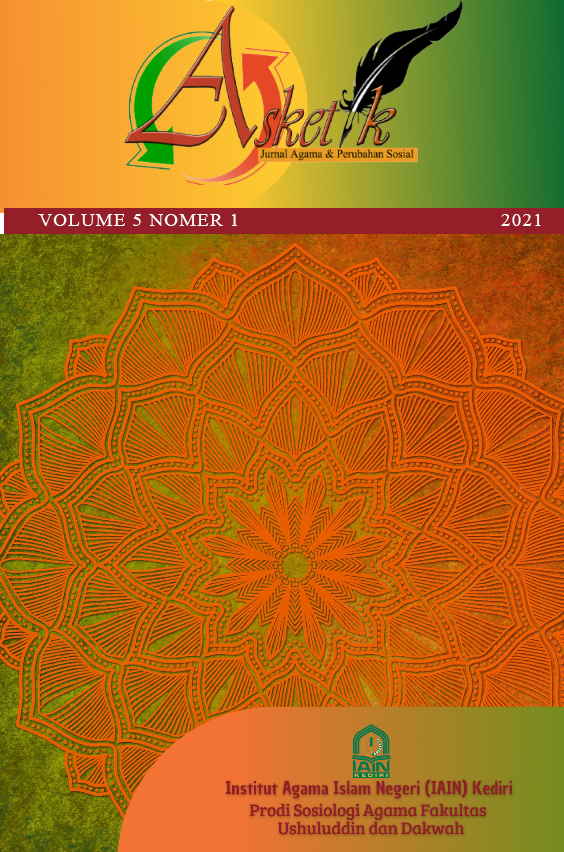Pertahanan Negara, Realitas Sosial Keagamaan, dan Ancaman Non-Militer Di Yogyakarta
DOI:
https://doi.org/10.30762/asketik.v5i1.116Keywords:
Non-Military Threats, National Security, Social Religion,YogyakartaAbstract
The concept and strategy of national security of Indonesia includes the resilience of all areas of the country against military and non-military threats. From a sociological perspective, non-military threats exist in a dynamic social and environmental world and are constantly changing in form. Non-military threats have a broader dimension, including ideological, social, economic, cultural, political, information technology and public safety. Various facts about regional conditions and socio-religious dynamics in the Special Region of Yogyakarta are indicators that show a source of problems as a potential non-military threat. The article from the field research using the following qualitative method contains an interpretive description of various non-military threats from internal conditions, as well as external influences. Internal conditions are caused by the Yogyakarta region which is directly adjacent to the Indian Ocean, the ring of fire area, and the city of study and tourism destinations. As for the external conditions for non-military threats, among others, due to the influence of globalization, geopololitical conditions, ideological flows such as radicalism and massive caiptalization from outside Indonesia. There are three forms of non-military threats in Yogyakarta that urgently need a strategy to respond and resolve them. The three non-military therats are religious radicalism, narcotics and illegal drugs, as well as the negative impact of virtual culture; such as the rise of hate and hoaxes that can damage unity, because it causes discord of the nation.
Downloads
References
Adorno, Th and Horkhieimer, M. (1979). Dialectif of Enlightenment. translated by Cumming, J. New York : Herder & Herder.
Ahnaf, M. Iqbal. 2016. Isis, molenbeek dan Radikalisme Urban. Yogyakarta: Artikel CRCS UGM.
Barker, Chris. (2011). Cultural Studies: Teori dan Praktik. Yogyakarta: Bentang Pustaka.
Baylis, John dan Smith, Steve (eds.). (2001). The Globalization of World Politics, 2nd edition. Oxford: Oxford University Press (2) Chap 7, 8, 9.
Badan Perencanaan Pembangunan Daerah - Badan Pusat Statistik. (2016). Analisis Informasi Statistik Pembangunan Daerah Istimewa Yogyakarta. Yogyakarta: BappedaBPS DIY.
Badan Pusat Statistik (BPS). (2019). Statistik Indonesia 2019. Jakarta: BPS.
Badan Nasional Penanggulangan Bencana (BNPB). (2016). Profil BNPB.
http://www.bnpb.go.id/home/sejarah. Burchill, Scott & Linkater, Andrew. (1996). Theories of International Relations. ST Martin Press: New York.
Buzan, Barry, Ole Waever and Jaap de Wilde. (1998). Security: A New Framework for Analysis. Boulder: Lynne Rienner
Castells, Manuel. (1996). The Rise of the Network Society: A Cross-cultural Perspective. Oxford: Blackwell Publisher.
---------------------. (1996). “The Culture of Real Virtuality: the Integration of Electronic Communication, the End of the Mass Audience, and the Rise of Interactive Networks,” dalam The Rise of the Network Society. Oxford: Central Intellegence Agency. (2016). CIA World Factbook 2016.
https://www.cia.gov/the-world-factbook/countries/.
Dasgupta, Sugata. (1968). “Peacelesness and Maldevelopment: A New Theme for Peace Research in Developing Nations,” Proceedings of the International Peace Research Association Second Conference, Assen, The Netherlands: Koninklijke Van Gorcum & Comp. vol.2, p.19-42
Dinas Kebudayaan DIY. (2015). Yogyakarta City of Philosophy. Yogyakarta: Dinas Kebudayaan DIY.
Dwiyanto, Djoko. (2017). Pemaknaan Keistimewaan DIY Antisipasi 2019. Dewan Kebudayaan DIY. Ppt. Materi Dewan Kebudayaan DIY. Tidak Diterbitkan.
Engel, James F. dkk. (1994). Perilaku Konsumen. Jakarta: Binarupa Aksara.
Earl, Esther, et.al., (2014). This Star Won’t Go Out. USA: Penguin Books.
Graham Murdock and Peter Golding. (1992). Political Economy of Mass Comunication (A Division of Holder & Stoughten).
Eriksen, Thomas Hyland. (2010). Etnicity and Nationalism Anthropological Approach. Third edition, London-Boulder, Colorado: Pluto Press.
Guur, Robert Ted. (1993). Minorities at Risk; a Critical View of Ethnopolitikal Conflicts. Washington DC: United States Institute of Peace Press.
Horkheimer, Max. (1997). Critical Theory. Continuum: New York
Horn, Stacy. (1998). Cyberville: Clicks, Culture, and the Creation of an Online Town. New York: Warner Books.
Horton, Paul B. dan Hunt, Chester L . (1996). Sosiologi. Jakarta: Erlangga.
Indrawan, Jerry. (2015). Studi Strategis dan Keamanan. Jakarta: Nadi Pustaka.
-------------------. (2016). “Ancaman Non-Militer Terhadap Keamanan Nasional di Papua”. Jurnal Ilmiah Hubungan Internasional PACIS. Vol.12 No.2.
Jackson, Robert dan Georg Sorensen. (1999). An Introduction to International Relations.
Oxford: Oxford University PressJones, Steven. 1997. Virtual Culture: Identity and Comunnication in Cybersociety. London: Sage Publications.
Khairuddin, N. (1995). Filsafat Kota Yogyakarta. Yogyakarta: Penerbit Liberty.
Kementerian Pertahanan Indonesia. (2015). Buku Putih Pertahanan Indonesia tahun 2015. Jakarta: Kemhan.
Kelly, Phil. (2006). “A Critique of Critical Geopolitics”. United Kingdom: Routledge Taylor & Francis Group, LLC, pp. 24-53
Leonard, Mark. (2015). Geoeconomics and 7 Challenges Globalization (online). dalam: http://www3.weforum.org/docs/WEF_Geoeconomics_7_Challenges_Globalization_2015_report.pdf(diakses pada 9 Mei 2016)
Marx, Karl. (1977). Selected Writing, ed. David Mclellan, Oxford: Oxford University Press. https://doi.org/10.30762/ask.v5i2.3842
Mas’oed, Mochtar., Maksum, Mochammad., dan Soehadha, Moh. (2001). Kekerasan Kolektif Kondisi dan Pemicu. Yogyakarta: P3PK UGM.
Matsuo, Masatsugu. (2005). Peace and Conflict Studies: A Theoretical Introduction. Hiroshima: Keisuisha
Miles, Matthew B. and Hubberman A. Michael. (1994). Data Management and Analysis Methods. In Denzim, Norman K. and Lincoln (edt). Hanbook of Qualitative Research. California: Sage Publication Inc.
Morissan dan Andy Corry Wardhani. (2009). Teori Komunikasi: tentang Komunikator, Pesan, Percakapan dan Hubungan. Jakarta: Ghalia Indonesia.
Mosco, Vincent. (1996). The Political Economy of Communication: Rethinking and Renewal. London: Sage Publication.
Naryadi. (2005). Keamanan Nasional Suatu Upaya Pemahaman. Bandung 4 Mei 2005, hal 9. Makalah Seminar. tt
Rozi, Safuan. (2003). “Mendorong Laju Gerakan Multikulturalisme di Indonesia.” Masyarakat Indonesia Majalah Ilmu-ilmu Sosial Indonesia. Jilid XXIX, No.1
Roberts, Susan et. al. (2003). Neoliberal Geopolitics. Oxford : Blackwell Publishing.
Rubaidi, A. (2008). Radikalisme Islam, Nahdlatul Ulama dan Masa Depan Moderatisme Islam di Indonesia. Yogyakarta: Penerbit Logung Pustaka bekerjasama dengan LTNU PWNU Jawa Timur.
Spinger, Simon, (2013). “Neoliberalism”, dalam The Ashgate Reasearch Companiaon to Critical Geopolitic. England: Ashgate Publishing Limited.
Santosa, Edy. Soehadha, Moh. Suprianto, Heri. Astuti, Nurcahyo Budi. dan Satria, Arif. 2017. Kajian Sinergitas Pembangunan di Daerah Istimewa Yogyakarta Guna Menghadapi Ancaman non-militer dalam Rangka Mendukung Penyelenggaraan Ketahanan Negara. Laporan PTT Kemhan DIY.
Satrinati, Dominic. (2003). Popular Culture – Pengantar Menuju Teori Budaya Populer. Yogyakarta: Bentang Budaya.
Soemardjan, Selo. (1982). Perubahan Sosial di Yogyakarta. Cetakan Kedua. Yogyakarta: Komunitas Bambu.
Soehadha, Moh. (2013). Belajar dari Negeri Cina: Reaktuaisasi Etos Kerja Islam. Opini Kedaulatan Rakyat 5/8.
Sudibyo, Bambang. (2013). Potret Pergeseran Geoperadaban, Geoekonomi, dan Geopolitik Abad 21. Makalah Seminar “ Reaktualisasi Etos Kerja Islam dan Pergeseran Geopolitik Cina”, 5 Agustus. Yogyakarta: Majelis Trajih dan Tajdid PP. Muhammadiyah.
Syafi’i, M. (2017). Klitih: Krisis Lingkungan Sosial. Majalah Pranala. Edisi 14, MaretApril.
Taylor, S., & Bogdan. (1984). Introduction to Qualitative Research Methods: The Search for Meanings. 2end ed. Toronto: John Wiley & Sons.
Tim Peneliti UIN Sunan Kalijaga. (2011). Ketahanan Kepribadian Mahasiswa DIY terhadap Sikap Eklusivisme Keagamaan. Yogyakarta: Laporan Penelitian tt.
Wardlaw, Grant. (1982). Political Terorism: Theory, Tactics and Countermeasures. Cambrige University Press.
Wallerstein, I. (1975). The Modern World System. Capitalist Agriculture and The Origins of European World Economy in The Sixteenth Century. New York: Academic.
Wijoyono, Erlanto. (2016). Pelestarian jejak Bencana sebagai Pusaka peradaban. https://elantowow.wordpress.com/2016/03/05/pelestarian-jejak-bencana-sebagai-pusaka-peradaban/#more-874
Woodward, Mark R. (2000). Islam Jawa: Kesalehan Normatif versus Kebatinan. Yogyakarta: Penerbit Berita Interfidei,
https://infogunungkidul.com/detail.php?id=1585
https://kumparan.com/nur-khafifah/bnn-narkoba-baru-jenis-flaka-mulai-masuk-keindonesia
http://wartakota.tribunnews.com/2017/09/14/apa-itu-pil-pcc-ini-penjelasan-bnn
http://www.beritasatu.com/blog/tajuk/4423-narkoba-kejahatan-luar-biasa.html
https://www.solopos.com/. NARKOBA JOGJA : BNNP DIY Targetkan Kurangi
Pengguna, Bagaimana Caranya? Kamis, 19 Januari 2017 | 02:20 WIB
Harian Kedaulatan Rakyat 15/9/2017
Kompas.com - 10/03/2017, 23:48 WIB
Kompas, 15 Agustus 2010.
Majalah Hadila, Januari 2017
Republika, 15 Agustus 2010.
Tempo 30/8/2017
www.jogjabudaya.com. dikutip tanggal 15 september 2017
www.koranopini.com, Kamis, 30 Maret 2017
Downloads
Published
How to Cite
Issue
Section
License
Copyright (c) 2021 Edy Santosa, Moh Soehadha, Heri Supriyanto

This work is licensed under a Creative Commons Attribution-ShareAlike 4.0 International License.





















